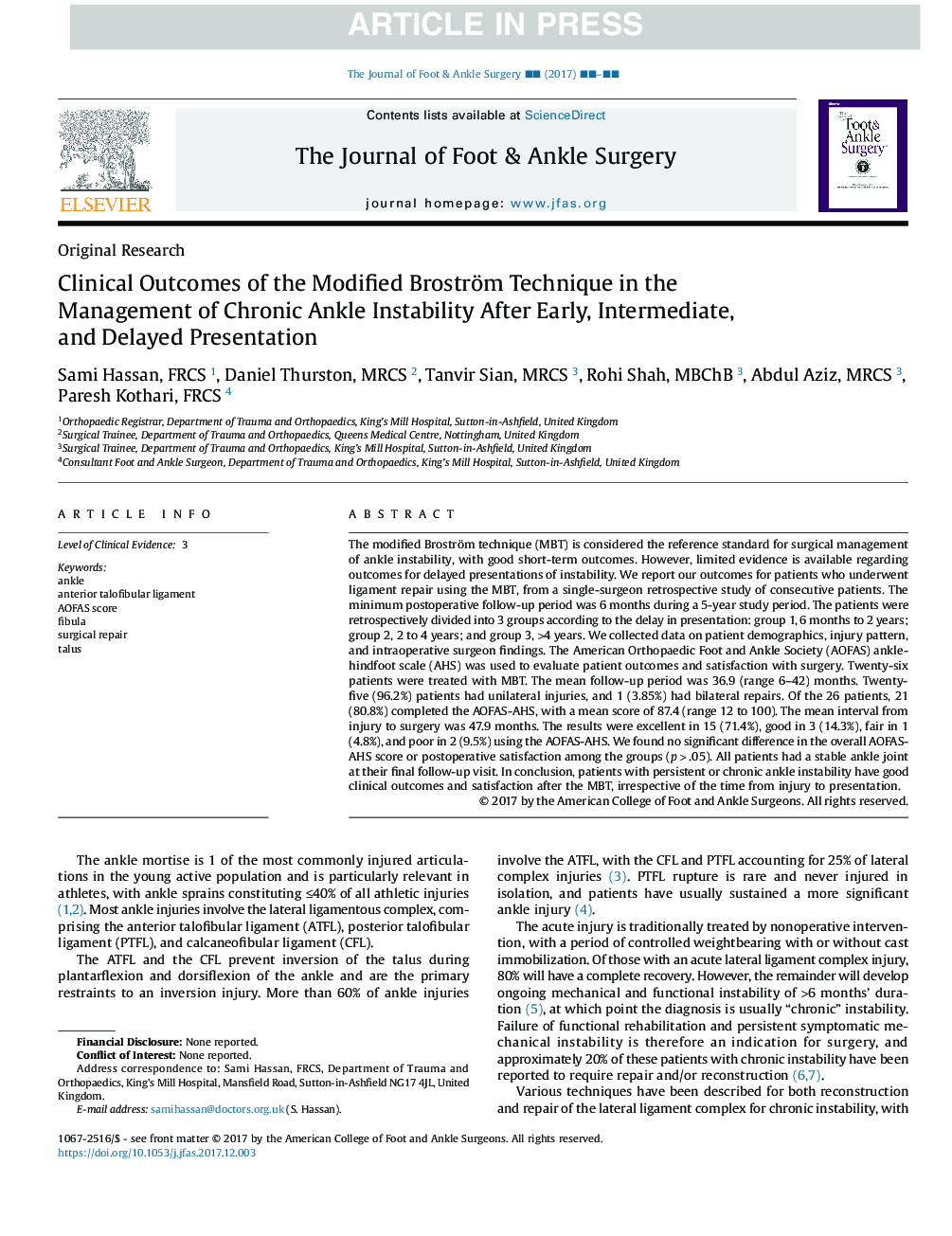| کد مقاله | کد نشریه | سال انتشار | مقاله انگلیسی | نسخه تمام متن |
|---|---|---|---|---|
| 8602824 | 1565510 | 2018 | 4 صفحه PDF | دانلود رایگان |
عنوان انگلیسی مقاله ISI
Clinical Outcomes of the Modified Broström Technique in the Management of Chronic Ankle Instability After Early, Intermediate, and Delayed Presentation
دانلود مقاله + سفارش ترجمه
دانلود مقاله ISI انگلیسی
رایگان برای ایرانیان
کلمات کلیدی
موضوعات مرتبط
علوم پزشکی و سلامت
پزشکی و دندانپزشکی
ارتوپدی، پزشکی ورزشی و توانبخشی
پیش نمایش صفحه اول مقاله

چکیده انگلیسی
The modified Broström technique (MBT) is considered the reference standard for surgical management of ankle instability, with good short-term outcomes. However, limited evidence is available regarding outcomes for delayed presentations of instability. We report our outcomes for patients who underwent ligament repair using the MBT, from a single-surgeon retrospective study of consecutive patients. The minimum postoperative follow-up period was 6 months during a 5-year study period. The patients were retrospectively divided into 3 groups according to the delay in presentation: group 1, 6 months to 2 years; group 2, 2 to 4 years; and group 3, >4 years. We collected data on patient demographics, injury pattern, and intraoperative surgeon findings. The American Orthopaedic Foot and Ankle Society (AOFAS) ankle-hindfoot scale (AHS) was used to evaluate patient outcomes and satisfaction with surgery. Twenty-six patients were treated with MBT. The mean follow-up period was 36.9 (range 6-42) months. Twenty-five (96.2%) patients had unilateral injuries, and 1 (3.85%) had bilateral repairs. Of the 26 patients, 21 (80.8%) completed the AOFAS-AHS, with a mean score of 87.4 (range 12 to 100). The mean interval from injury to surgery was 47.9 months. The results were excellent in 15 (71.4%), good in 3 (14.3%), fair in 1 (4.8%), and poor in 2 (9.5%) using the AOFAS-AHS. We found no significant difference in the overall AOFAS-AHS score or postoperative satisfaction among the groups (pâ>â.05). All patients had a stable ankle joint at their final follow-up visit. In conclusion, patients with persistent or chronic ankle instability have good clinical outcomes and satisfaction after the MBT, irrespective of the time from injury to presentation.
ناشر
Database: Elsevier - ScienceDirect (ساینس دایرکت)
Journal: The Journal of Foot and Ankle Surgery - Volume 57, Issue 4, JulyâAugust 2018, Pages 685-688
Journal: The Journal of Foot and Ankle Surgery - Volume 57, Issue 4, JulyâAugust 2018, Pages 685-688
نویسندگان
Sami FRCS, Daniel MRCS, Tanvir MRCS, Rohi MBChB, Abdul MRCS, Paresh FRCS,